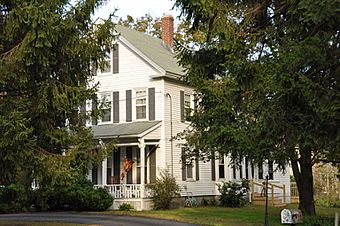Buck's Corner Historic District facts for kids
Quick facts for kids |
|
|
Buck's Corner Historic District
|
|

590 Woburn Street
|
|
| Location | Wilmington, Massachusetts |
|---|---|
| Area | 9.88 acres (4.00 ha) |
| Architectural style | Federal, Italianate |
| MPS | First Period Buildings of Eastern Massachusetts TR |
| NRHP reference No. | 03001209 |
| Added to NRHP | November 21, 2003 |
The Buck's Corner Historic District is a special area in Wilmington, Massachusetts. It's like a time capsule, showing how homes used to look from the late 1600s to the late 1800s. This district covers about 10 acres (or 4 hectares) and includes six old houses and three barns. Many of these buildings are connected to the Buck family, especially Roger and Ephraim Buck, who were early settlers. The district was added to the National Register of Historic Places in 2003 because of its important history.
Contents
Exploring Buck's Corner Historic District
This historic district is found in eastern Wilmington. It used to be a quiet, rural area, but now it's more suburban. The homes here show different building styles from over 200 years of history.
Homes from Long Ago
Some of the oldest houses in the district have stories stretching back centuries. They give us a peek into how people lived long ago.
The Ephraim Buck House: A Journey Through Time
The Ephraim Buck House at 216 Wildwood Street is one of the oldest. People believe its first part was built around 1704. Later, in the 1740s, another section was added. Around 1770, the house got a new look with a popular style called Federal. This included tall, narrow windows next to the front door and a decorative frame above it.
Other Early Homes
The Daniel Eames House at 584 Woburn Street might also have been built by Ephraim Buck, between 1714 and 1723. It's a good example of an early Georgian-style house. Another old house, at 604 Woburn Street, was once thought to be from the 1600s. However, experts now believe it was built later, around 1785-1791, in the Federal style.
Later Homes and Styles
As time went on, new building styles became popular. The district also includes houses from the 1800s, showing these changes.
Different Architectural Styles
The Jonathan Buck House (571 Woburn Street) was built between 1795 and 1820. It's a great example of Federal architecture in Wilmington. It's one of the few houses in town with a hip roof from that time. This house has five windows across the front and two windows deep. Its front door has full-length windows on the sides and decorative pillars.
Other houses in the district were built later in the 1800s:
- The Henry Sheldon House (603 Woburn Street) was built around 1861-1862. It's designed in the Italianate style, which often features wide eaves and decorative brackets.
- The John Howard Eames House (590 Woburn Street) was built around 1883. It's a beautiful Queen Anne Victorian style home, known for its towers, turrets, and decorative details.
Three of these houses still have their original 19th-century barns, which are also part of the historic district. The Ephraim Buck House used to have a barn too, but it was taken down.
What Makes a Historic District Special?
A historic district is a group of buildings that share a common history or architectural style. They are protected to help people remember and learn about the past. Not every building in a historic district adds to its special meaning. For example, a modern house built in 1999 at 588 Woburn Street is not considered historic. Another house at 580 Woburn Street was built in the Italianate style around 1856-1875. But it was changed so much that it no longer looks like its original historic self. Sadly, a Buck family house from the late 1700s at 585 Woburn Street was torn down before the district was officially created.



